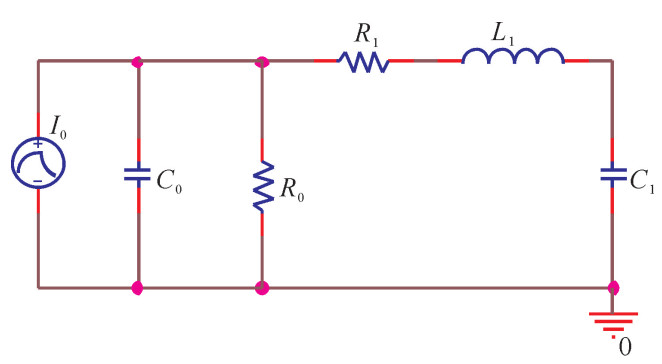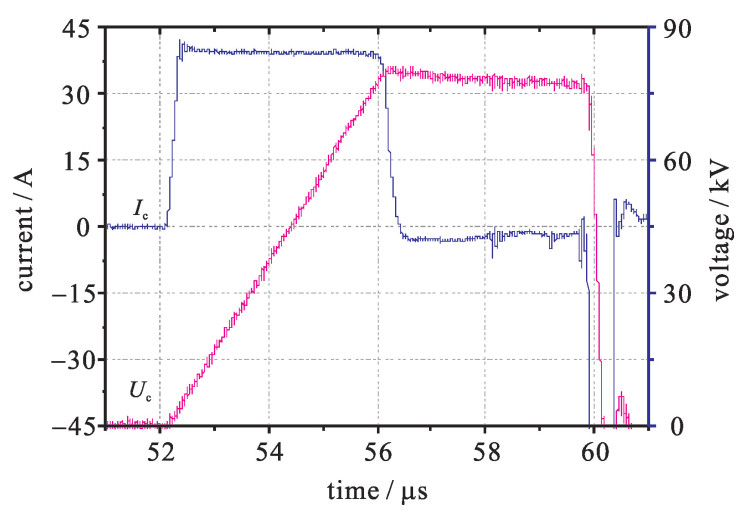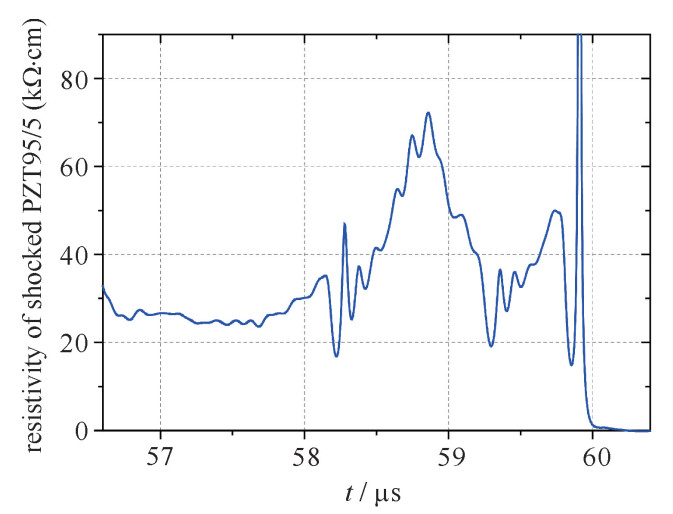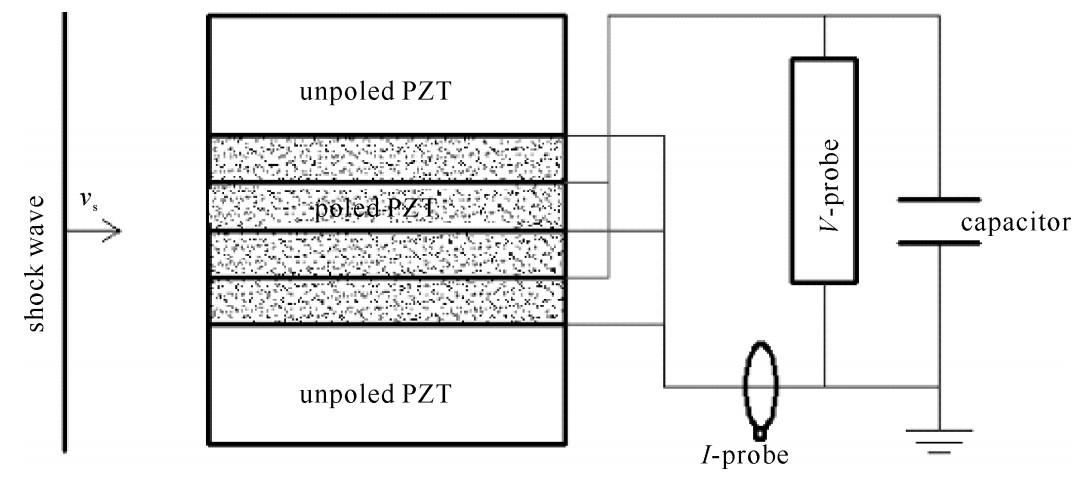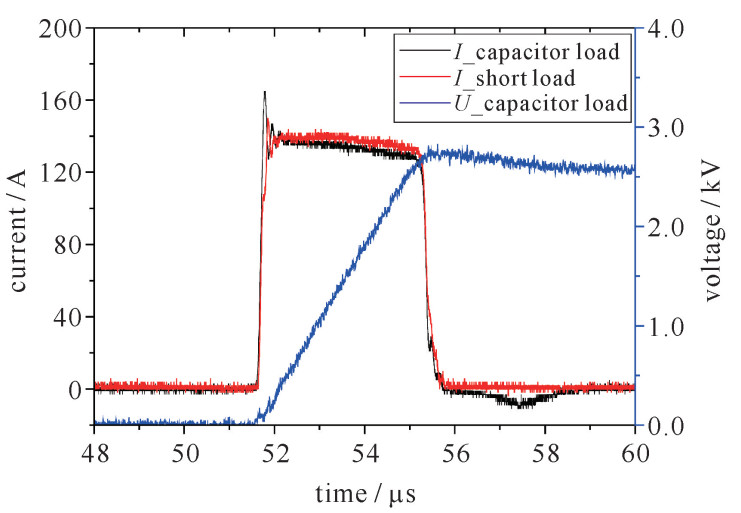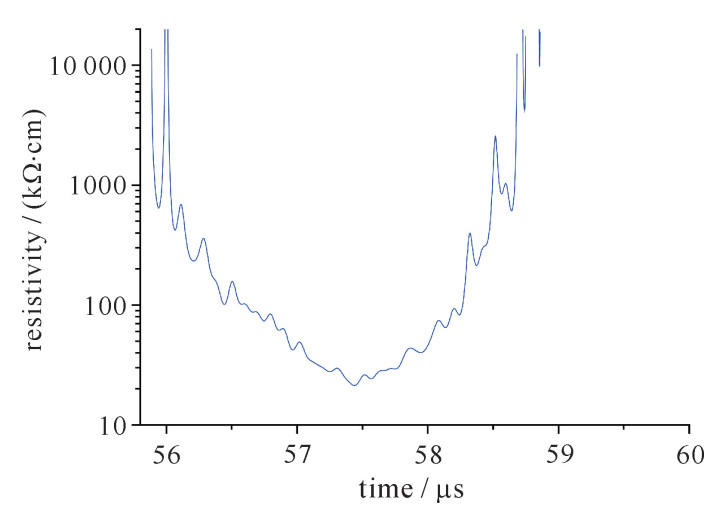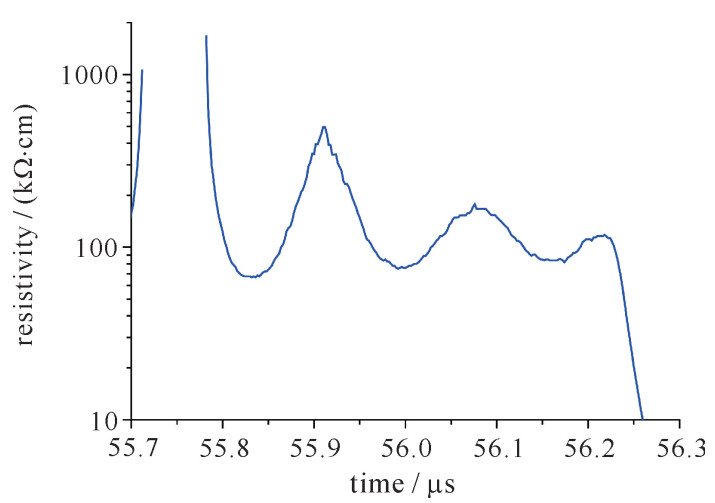Resistivity properties of ferroelectric ceramics and its effects on output charges in explosion-driven ferroelectric generator
-
摘要: 爆炸驱动铁电体脉冲电源利用铁电陶瓷在冲击压力作用下去极化释放电荷而产生电流,可以作为脉冲功率源的初始电源,也可直接驱动高阻抗负载产生脉冲高电压。通常情况下,铁电陶瓷可以看作理想的绝缘体,但在数GPa冲击波压力作用下,铁电陶瓷电阻率可能会明显下降并形成漏电导,使部分去极化释放电荷在铁电陶瓷内部流失,导致铁电陶瓷剩余极化电荷输出效率下降。以PZT95/5铁电陶瓷作为初始储能介质,以爆炸冲击波加载PZT95/5铁电陶瓷释放电荷对脉冲电容器充电,充电结束后电容器电压维持期间检测到明显的反向电流,根据铁电陶瓷输出电流和工作电压,得到冲击波作用过程中铁电陶瓷的瞬态电阻率曲线,并分析了电阻率下降对输出电荷的影响。进一步研究表明,冲击压力在铁电陶瓷边侧产生的稀疏波是引起电荷输出效率降低的主要因素,而铁电陶瓷电阻率下降对电荷输出效率的影响很小。Abstract: Explosion-driven ferroelectric generator (EDFEG) has important applications due to its excellent properties of high energy density and small volume. The output of EDFEG is based on the depolarization of ferroelectric during shock wave compression. In the present work, a new experiment method was developed to investigate dynamic resistivity of PZT95/5 under shock wave compression, in which a pulse capacitor was used as an output load. A current leakage in shocked PZT95/5 was observed in the experiment at a shock stress of 3.5 GPa after the depolarization of all ferroelectrics. This current leakage was just related to the resistance of shocked PZT95/5 and the voltage applied. The resistivity of shocked PZT95/5 was calculated for a longer time than the shock transit time of the sample. The factors that reduced the efficiency of output charge were analyzed. Furthermore, new experiments were designed to eliminate the effect on depolarization of ferroelectrics from boundary rarefaction. Two shots of experiments with different capacitance loads produced different voltages across the PZT95/5 ferroelectrics stack. These experimental results show that efficiency of output charge was improved obviously, and that the higher the electric field was, the more the resistance of PZT95/5 ferroelectrics decreased. In conclusion, the resistivity of ferroelectric ceramics has little effect on the efficiency of output charge from ferroelectric ceramics.
-
Key words:
- ferroelectric ceramics /
- depolarization /
- pulsed power supply /
- resistivity /
- charge
-
表 1 电阻特性实验条件及实验数据
Table 1. Conditions and results of resistance characteristic experiment
no. C1/nF Ucm/kV QC1/μC QC0/μC charge density/(μC·cm-2) charge loss/μC 1-short short 0 507.5 0 37.6 0 1-load 186 2.7 501.5 3.1 37.4 2.9(0.6%) 2-short short 0 503.2 0 37.3 0 2-load 92 5.3 487.5 8.3 36.7 7.4(1.5%) -
[1] 刘高旻, 刘雨生, 张毅, 等. PZT铁电陶瓷及其在脉冲能源中的应用[J]. 材料导报, 2006, 20 (6): 74-77. doi: 10.3321/j.issn:1005-023X.2006.06.020Liu Gaomin, Liu Yusheng, Zhang Yi, et al. PZT ferroelectric ceramic for shock-driven pulsed power supply. Materials Review, 2006, 20 (6): 74-77 doi: 10.3321/j.issn:1005-023X.2006.06.020 [2] Schoeneberg N, Walter J, Neuber A, et al. Ferromagnetic and ferroelectric materials as seed sources for magnetic flux compressors[C]//Proc of 14th IEEE International Pulsed Power Conference, 2003: 1069-1072. [3] Shkuratov S I, Talantsev E F, Menon L, et al. Compact high-voltage generator of primary power based on shock wave depolarization of lead zirconate titanate piezoelectric ceramics[J]. Review of Scientific Instrument, 2004, 75 (8): 2766-2769. doi: 10.1063/1.1771490 [4] Shkuratov S I, Baird J, Talantsev E F, et al. Effect of shock front geometry on shock depolarization of Pb(Zr0. 52Ti0. 48)O3 ferroelectric ceramics[J]. Review of Scientific Instruments, 2012, 83: 074702. doi: 10.1063/1.4732809 [5] Bolyard D, Neuber A, Krile J, et al. Scaling and improvement of compact explosive-driven ferroelectric generators[C]//Proc of IEEE International Power Modulators and High Voltage Conference. 2008: 49-52. [6] 刘高旻, 张毅, 杜金梅, 等. PZT 95/5-2Nb铁电陶瓷脉冲换能电输出[J]. 功能材料与器件学报, 2007, 13 (4): 371-374. doi: 10.3969/j.issn.1007-4252.2007.04.013Liu Gaomin, Zhang Yi, Du Jinmei, et al. Electrical output of PZT95/5-2Nb pulsed power supply. Journal of Function Materials and Devices, 2007, 13 (4): 371-374 doi: 10.3969/j.issn.1007-4252.2007.04.013 [7] Shkuratov S I, Baird J, Antipov V G, et al. Depolarization mechanisms of Pb(Zr0. 52Ti0. 48)O3 and Pb(Zr0. 95Ti0. 05) O3 poled ferroelectrics under high strain rate loading[J]. Applied Physics Letters, 2014, 104: 212901. doi: 10.1063/1.4879545 [8] 冯玉军, 徐卓, 郑曙光, 等. 反铁电爆电换能电源研究[J]. 西安交通大学学报, 2002, 36 (6): 584-587. doi: 10.3321/j.issn:0253-987X.2002.06.009Feng Yujun, Xu Zhuo, Zheng Shuguang, et al. Explosive to electrical power with ferroelectric anti-ferroelectric transitions. Journal of Xi'an Jiaotong University, 2002, 36 (6): 584-587 doi: 10.3321/j.issn:0253-987X.2002.06.009 [9] Altgilbersv L L, Baird J, Freeman B L, et al. Explosive pulsed power[M]. Singapore: Imperial College Press, 2011. [10] Halpin W J. Resistivity estimates for some shocked ferro-electrics[J]. Journal of Applied Physics, 1968, 39 (8): 3821-3826. doi: 10.1063/1.1656860 [11] Zhang Fuping, Liu Yusheng, Xie Qinghai, et al. Electrical response of Pb(Zr0. 95Ti0. 05)O3 under shock compressions[J]. Journal of Applied Physics, 2015, 117: 134104. doi: 10.1063/1.4916710 [12] Lysne P C. Resistivity of shock wave compressed PZT95/5[J]. Journal of Applied Physics, 1977, 48 (11): 4565-4568. doi: 10.1063/1.323480 [13] Setchell R E. Shock wave compression of the ferroelectric ceramic Pb0. 99 (Zr0. 95Ti 0. 05) 0. 98Nb0. 02O3: Depoling currents[J]. Journal of Applied Physics, 2005, 97 : 013507. doi: 10.1063/1.1828215 [14] Zhang Fuping, He Hongliang, Liu Gaomin, et al. Failure behavior of Pb(Zr0. 95Ti0. 05)O3 ferroelectric ceramic under shock compression[J]. Journal of Applied Physics, 2013, 113: 183501. doi: 10.1063/1.4803052 -





 下载:
下载:
